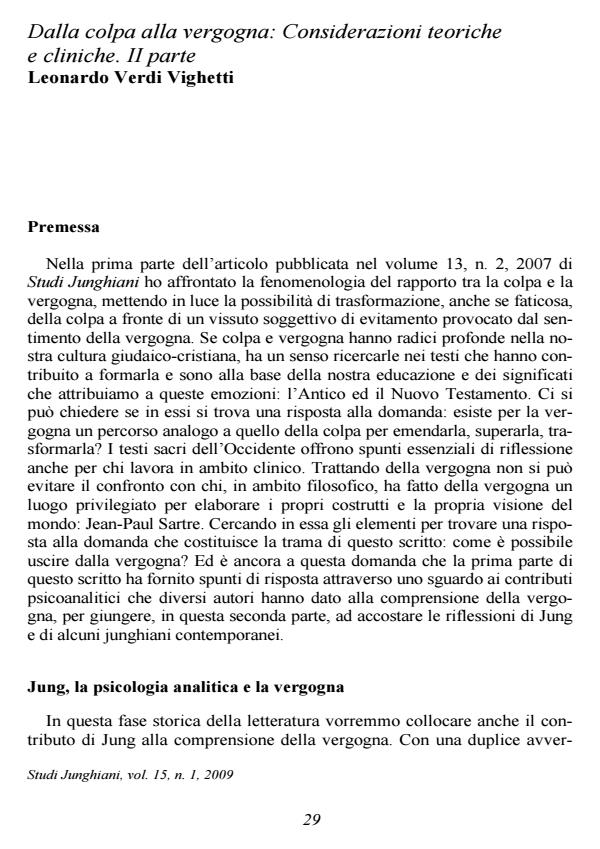Dalla colpa alla vergogna: Considerazioni teoriche e cliniche. II parte
Journal title STUDI JUNGHIANI
Author/s Vignetti Leonardo Verdi
Publishing Year 2009 Issue 2009/29
Language Italian Pages 22 P. 29-50 File size 383 KB
DOI 10.3280/JUN2009-029002
DOI is like a bar code for intellectual property: to have more infomation
click here
Below, you can see the article first page
If you want to buy this article in PDF format, you can do it, following the instructions to buy download credits

FrancoAngeli is member of Publishers International Linking Association, Inc (PILA), a not-for-profit association which run the CrossRef service enabling links to and from online scholarly content.
From guilt to shame: clinical and theoretical notes. II part - C.G. Jung didn’t face the problem of shame directly as he did with guilt, but nevertheless in Memories, dreams and reflections (1961) he refers an episode of his life in which it is possible to trace a phenomenology of this feeling and its evolution towards the discovery of personal dignity and responsibility. Some clinical references confirm this possible transformation. Shame seems to be an experience with an ethic potential (which can be used in a constructive or destructive way) which generates awareness. Shame is the feeling that accompanies the confrontation with the Shadow, since its more precocious manifestations, and therefore seems to be concomitant with the birth of conscience. Analysing the figure of the Trickster, it is possible to understand the meaning of shame. The archaic angst of shame, due to the lack of emphatic relationship between the mother and her child, asks for an analytical experience of emphatic understanding, capable to hold and to keep in contact with the patient’s feeling of fragmentation. It means to listen and to reconstruct more than to interpret. Shame is a kind of "hologramemotion" where the part reflects the wholeness. The Author offers some clinical examples to face and to value shame as a transforming resource in the path towards individuation.
Parole chiave: inadeguatezza, inferiorità, evitamento, vergogna dell’essere, emendabilità, empatia
Key words: inadequacy, inferiority, avoidance, shame of being, emendability, empathy
- La vitalità del corpo nella relazione di transfert-controtransfert. Il trickster nel lavoro analitico con i bambini Emanuela Pasquarelli, in STUDI JUNGHIANI 37/2014 pp.29
DOI: 10.3280/JUN2013-037003
Vignetti Leonardo Verdi, Dalla colpa alla vergogna: Considerazioni teoriche e cliniche. II parte in "STUDI JUNGHIANI" 29/2009, pp 29-50, DOI: 10.3280/JUN2009-029002